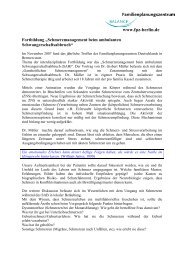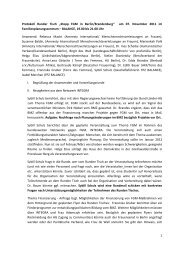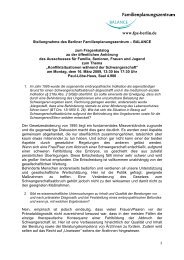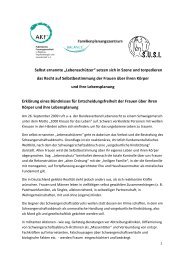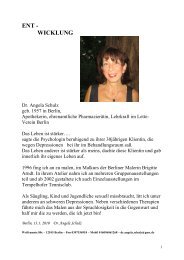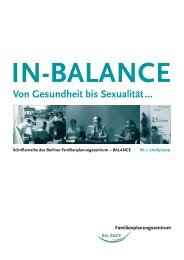however, that awareness was significantly lower amongimmigrants from practicing families than among familiesby whom FGM/C is not carried out. The level of awarenessof men and women was comparable although men frompracticing families showed less knowledge than women frompracticing families. The level of education plays a role: thedegree of awareness increases with the education level. Theimmigrant communities with the lowest level of awarenesscome from two countries with very high prevalence rates:Guinea and Gambia. This might be due <strong>to</strong> the relatively loweducation level of immigrants from these two countries. Menfrom Nigeria also showed a relatively low level of awareness.The knowledge of harm and risks was particularly highamong immigrants from Cote d’Ivoire, Cameroon, Togo,Kenya and Ethiopia.6.4. Do they know that practices such as FGM/C areillegal in Germany?There is a strong awareness among immigrant populationsthat FGM/C is not <strong>to</strong>lerated in Germany. The awareness wasslightly lower among women from practicing groups andgenerally lower in practicing families from high prevalencecountries in West Africa.The court cases in France in which parents and practitionersof FGM/C were condemned have not gone unnoticed. Othercases of prosecution have also become public and the mediaand word-of-mouth communication have helped <strong>to</strong> spreadthe word. Although most of the immigrants have no specificknowledge of how the German legal system considers orrefers <strong>to</strong> FGM/C, they know that “the Germans are againstit.” Furthermore, many immigrants from Sub-Saharan Africahave had recurrent adverse experiences of how strictly therules and regulations are applied in Germany (passport andticket controls, restrictions of their residence permit). Theyquickly assimilate that – unlike in their country of origin– there is little or no room for negotiation when rules arebroken.These experiences combined with the knowledge thatFGM/C is condemned by Europeans have a strong dissuasiveeffect on practicing families. They fear that subjectingtheir daughters <strong>to</strong> the practice could jeopardise their status,so they opt either <strong>to</strong> abstain from the practice or <strong>to</strong> sendthe girl <strong>to</strong> the country of origin in order <strong>to</strong> subject her <strong>to</strong>FGM/C.6.5. How many girls and women have undergoneFGM/C?6.5.1. The proportion of adult women who have undergoneFGM/CThe results of the current study indicate that about 30% ofthe <strong>to</strong>tal immigrant women population in Hamburg has undergoneFGM/C. The prevalence rate of the country of originis not always a reliable indica<strong>to</strong>r. While it worked well forcountries with high prevalence rates (> 70%), it proved <strong>to</strong>be misleading for women and girl populations from countrieswith low and moderate prevalence rates:• Countries of origin with high prevalence rates: Theprevalence rate among the women interviewed who werefrom countries with a high prevalence of FGM/C such asGuinea and Gambia was comparable <strong>to</strong> the prevalence rateof the country of origin.• Countries of origin with low <strong>to</strong> moderate prevalencerates: The prevalence rates are of little use when estimatingthe number of immigrant women concerned. InHamburg, the prevalence rates among women immigrantsfrom some countries is much higher than the nationalprevalence rate of the country of origin. In Nigeria, forexample, the national prevalence rate is about 30%. Mostimmigrants living in Hamburg, however, come from thestrongly practicing Southern regions, and at least 50% ofthe women of Nigerian origin in Hamburg have undergoneFGM/C. Similar tendencies became apparent among Togoleseand Beninese women.6.5.2. The proportion of girls who have undergone FGM/Cor who are at risk of being subjected <strong>to</strong> the practice(< 18 years)The prevalence rates of the countries of origin are not auseful indica<strong>to</strong>r for determining the number of girls livingin Hamburg who have been subjected <strong>to</strong> the practice. Inthe cohort of immigrants’ daughters, the proportion of girlsconcerned is significantly lower. Nevertheless, an importantdistinction has <strong>to</strong> be made between (1) daughters who grewup in the country of origin, (2) daughters who were born inAfrica and who migrated with their parents <strong>to</strong> Europe and(3) daughters who were born in Germany.Daughters of practicing families who grew up in the countryof origin have little or no protection from FGM/C. The migratingparent is often not even informed when the daughteris subjected <strong>to</strong> the practice. As a consequence, the numberof circumcised daughters growing up in Africa among immigrantsfrom Gambia, Guinea, Mali or Nigeria is high.<strong>Listening</strong> <strong>to</strong> <strong>African</strong> <strong>Voices</strong> 89
Daughters who were born in Africa and who migrate duringchildhood <strong>to</strong> Europe often undergo the practice before arrivingin Europe. The probability depends on the age of the girlat the moment of migration and the age at which FGM/C isusually carried out in the community of origin.Daughters who were born in Germany are the lowest riskgroup. Depending on their family in the country of origin (orin France or Italy), they might be subjected <strong>to</strong> the practiceduring holidays or extended stays in the country of origin.The girls growing up in Hamburg belong – of course – <strong>to</strong>the second and third group. The fi ndings showed that thereis a small, but considerable number of girls who underwentFGM/C before coming <strong>to</strong> Hamburg. Further, the researchteam judged that 13 daughters of immigrants were at riskfor FGM/C during trips home. This indicates that otherolder girls have already taken that path and returned <strong>to</strong>Hamburg after undergoing FGM/C. There is therefore arelatively small number of girl children in Hamburg whohave been subjected <strong>to</strong> the practice or risk being subjected<strong>to</strong> it in the future.The research could not establish any evidence that FGM/Chas been carried out in Hamburg or other locations inGermany. There were only vague indications that it could bepracticed on infants from the ethnic group of the Yoruba orIgbo of Nigerian origin.If girls are subjected <strong>to</strong> the practice, the parents prefer <strong>to</strong>send them for an extended stay <strong>to</strong> the country of origin or,in some cases, <strong>to</strong> France. In order <strong>to</strong> determine whether aparticular girl is at risk, numerous fac<strong>to</strong>rs have <strong>to</strong> be takenin<strong>to</strong> account. The prevalence rate of the region of originis just one of many fac<strong>to</strong>rs. The place of residence (urban/rural), the ethnic group affiliation, the education level of theparents, the socio-demographic profile and opinions of thetwo parents, the level of integration in<strong>to</strong> German way, theirattachment <strong>to</strong> their home community are just a few variables<strong>to</strong> be assessed. The findings illustrate, however, thatthe group of girls at risk are a rather small minority. Mostimmigrants in Hamburg from practicing families abstain fromsubjecting their daughters <strong>to</strong> FGM/C for one or more of thefollowing reasons:• Fear of punishment, as the act might be discovered forexample during health check ups or swimming lessons.When immigrants have <strong>to</strong> decide between jeopardisingtheir status and continuing the practice of FGM/C,they will opt in favour of maintaining their status. Havingmigrated for labour, they have large families <strong>to</strong> supportin Africa and returning <strong>to</strong> Africa without having made afortune is not an option for them.• High level of education and integration and awarenessabout the risks and harmful consequences of FGM/C;• The other parent is from a non-practicing community andis opposed <strong>to</strong> the practice;• Lack of opportunities due <strong>to</strong> the absence of the societalsetting of the community of origin, including a network oftraditional or modern practitioners;• Flights <strong>to</strong> Africa are expensive and many immigrants don’thave the means <strong>to</strong> fl y the daughter home for this reasonexclusively;• Other more urgent preoccupations related <strong>to</strong> their statusas immigrants (e. g. linked <strong>to</strong> accommodation, residence orwork permit).Nonetheless, if a girl is from a practicing group, the risk cannever be <strong>to</strong>tally eliminated.6.6. Summary of the situation of the immigrant populations(per country of origin)6.6.1. Typologies of different immigrant communitiesThe analysis of the immigrant populations by country and byregion of origin enabled <strong>to</strong> classify most countries and someparticular regions in a typology based on the three elements:the FGM/C prevalence in the country or region of origin,the proportion of women who have undergone FGM/C aswell as the degree of risk experienced by girls growing upin Hamburg that they might be subjected <strong>to</strong> the practice.For three countries – Ghana, Benin and Togo – the nationalFGM/C prevalence proved <strong>to</strong> be an unreliable indica<strong>to</strong>r andpreference was given <strong>to</strong> distinguishing immigrants fromthese countries according <strong>to</strong> their region of origin.The typologies according <strong>to</strong> the three elements namedabove allow the determination of the need for interventionagainst FGM/C.• First, there are immigrant populations with a pressingneed for intervention: many women have been subjected<strong>to</strong> the practice and might be in need of assistance and thefindings indicated the existence of girls at risk of beingsubjected <strong>to</strong> the practice.• Second, there are communities with moderate need for intervention:there is a moderate or high number of womenconcerned, but due <strong>to</strong> the level of education and integrationor other characteristics of the immigrant community,the immigrants show little or no interest in continuing <strong>to</strong>practice FGM/C.• Finally, there are immigrant populations from Sub-SaharanAfrica with little or no need for intervention: FGM/Cis not part of their cultural practices. It still makes sense<strong>to</strong> include these populations in campaigns against FGM/Cas they can make valuable contributions <strong>to</strong> the discus-90<strong>Listening</strong> <strong>to</strong> <strong>African</strong> <strong>Voices</strong>






